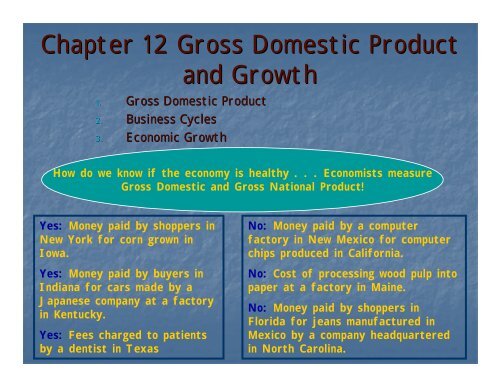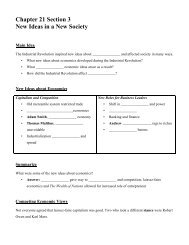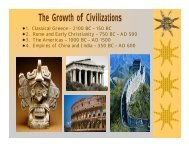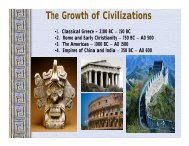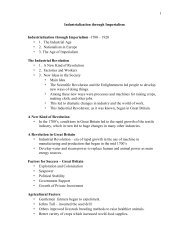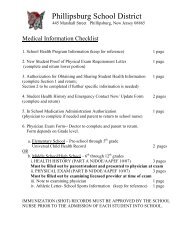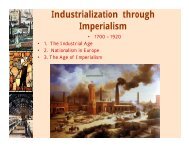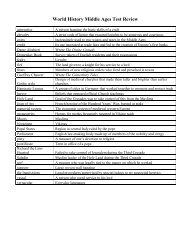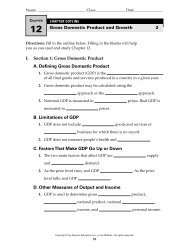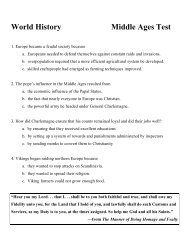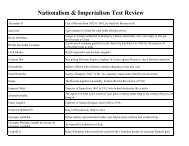Gross Domestic Product and Economic Growth Power Point Notes
Gross Domestic Product and Economic Growth Power Point Notes
Gross Domestic Product and Economic Growth Power Point Notes
Create successful ePaper yourself
Turn your PDF publications into a flip-book with our unique Google optimized e-Paper software.
Chapter 12 <strong>Gross</strong> <strong>Domestic</strong> <strong>Product</strong><br />
<strong>and</strong> <strong>Growth</strong><br />
1. <strong>Gross</strong> <strong>Domestic</strong> <strong>Product</strong><br />
2. Business Cycles<br />
3. <strong>Economic</strong> <strong>Growth</strong><br />
How do we know if the economy is healthy . . . Economists measure<br />
<strong>Gross</strong> <strong>Domestic</strong> <strong>and</strong> <strong>Gross</strong> National <strong>Product</strong>!<br />
Yes: Money paid by shoppers in<br />
New York for corn grown in<br />
Iowa.<br />
Yes: Money paid by buyers in<br />
Indiana for cars made by a<br />
Japanese company at a factory<br />
in Kentucky.<br />
Yes: Fees charged to patients<br />
by a dentist in Texas<br />
No: Money paid by a computer<br />
factory in New Mexico for computer<br />
chips produced in California.<br />
No: Cost of processing wood pulp into<br />
paper at a factory in Maine.<br />
No: Money paid by shoppers in<br />
Florida for jeans manufactured in<br />
Mexico by a company headquartered<br />
in North Carolina.
National Income Accounting<br />
• System to collect <strong>and</strong> organize macroeconomic statistics on<br />
production, income, investment, <strong>and</strong> savings<br />
• Under the Department of Commerce<br />
Cabinet position in the Executive Branch of government<br />
whose main focus to promote economic growth.<br />
Hello, I am Gary Locke, the<br />
Secretary of Commerce in<br />
President Obama’s Cabinet. I<br />
am the first Chinese-American<br />
Secretary. I was two term<br />
governor of Washington, the<br />
nation’s most trade-dependent<br />
state.
1. <strong>Gross</strong> <strong>Domestic</strong> <strong>Product</strong><br />
• Dollar Value - cash value of all goods <strong>and</strong> services<br />
• Final Goods <strong>and</strong> Services - All goods/services offered to<br />
consumers<br />
• Within a Country’s s border - American <strong>and</strong> foreign within U.S.<br />
• tracks the exchange of money<br />
DOLLAR VALUE<br />
YES: Cash value of<br />
all goods <strong>and</strong><br />
services sold<br />
NO: Cost of<br />
producing goods <strong>and</strong><br />
services<br />
FINAL GOODS AND<br />
SERVICES<br />
YES: Goods <strong>and</strong><br />
services offered to<br />
consumers<br />
NO: Intermediate<br />
goods used to<br />
produce other goods<br />
<strong>and</strong> services<br />
WITHIN A<br />
COUNTRYS BORDER<br />
YES: American or<br />
foreign companies<br />
producing in the<br />
United States<br />
NO: American<br />
companies producing<br />
overseas
Calculated Two Ways<br />
• Expenditure Approach -what we spend<br />
• Consumer, business, <strong>and</strong> government goods <strong>and</strong> services as<br />
well as net exports<br />
• Durable goods - goods that last awhile<br />
• Non durable goods - short period of time<br />
• Income Approach -what we make<br />
• firm sells a product or service, the selling price minus the<br />
dollar value of goods/services<br />
• In theory, they should give us same total
Expenditure Approach<br />
• Suppose an economy’s entire output is cars <strong>and</strong> trucks. This year the<br />
economy produces:<br />
• 10 cars at $15,000 each = $150,000<br />
• 10 trucks at $20,000 each = $200,000<br />
• total = $350,000<br />
• The economy’s GDP for this year is $350,000!<br />
Income Approach<br />
• Suppose an economy’s entire output is cars <strong>and</strong> trucks.<br />
• All employed citizens, therefore, would work in the car <strong>and</strong> truck<br />
industry, or for its suppliers.<br />
• The combined selling price of all the cars <strong>and</strong> trucks reflects the<br />
money paid to all the people who helped build the vehicles.<br />
• The economy’s GDP for this year, then, is the sum of the income of<br />
all its working citizens, or $350,000 (This includes the combined<br />
income of all engineers, designers, planners, assembly-line workers,<br />
managers, suppliers, etc.)~<br />
• The economy’s GDP for this year is $350,000!
Nominal Versus Real GDP<br />
• Nominal - GDP measured in current prices<br />
• Real - GDP measured in constant, unchanging prices<br />
Year 1: Nominal GDP<br />
•Suppose an economy’s<br />
entire output is cars <strong>and</strong><br />
trucks.<br />
•This year the economy<br />
produces:<br />
10 cars at $15,000 each =<br />
$150,000<br />
10 trucks at $20,000 each =<br />
$200,000<br />
350,000<br />
•Since we have used the<br />
current year’s prices to<br />
express the current year’s<br />
output, the result is a<br />
nominal GDP of $350,000<br />
Year 2: Nominal GDP<br />
•In the second year, the<br />
economy’s output does not<br />
increase, but he prices of<br />
the cars <strong>and</strong> trucks do:<br />
10 cars at $16,000 each =<br />
$160,000<br />
10 trucks at $21,000 each =<br />
$210,000<br />
370,000<br />
•This new GDP figure of<br />
$370,000, is misleading. GDP<br />
rises because of an increase<br />
in prices. Economists prefer<br />
to have measure of GDP that<br />
is not affected by changes in<br />
prices. So they calculate real<br />
GDP.<br />
Year 3: Real GDP<br />
•To correct for an increase<br />
in prices, economists<br />
establish a set of constant<br />
prices by choosing one year<br />
as a base year. When the y<br />
calculate real GDP for other<br />
years, they use the prices<br />
from the base year. So we<br />
calculate the real GDP for<br />
Year 2 using the prices from<br />
Year 1:<br />
10 cars at $15,000 each =<br />
$150,000<br />
10 trucks at $20,000 each =<br />
$200,000<br />
350,000<br />
•Real GDP is $350,000
Limitations of GDP<br />
• Non-market activities -wash car, mow lawn<br />
• The Underground economy - black market<br />
• Negative Externalities - power plants polluting<br />
• Quality of Life - leisure time<br />
What do you<br />
mean I’m not<br />
counted<br />
toward the<br />
GDP<br />
Look at the Pollution!
Other Output <strong>and</strong> Income<br />
Measures<br />
• <strong>Gross</strong> National <strong>Product</strong> - the annual income earned by a nation’s<br />
firm <strong>and</strong> citizens<br />
• Does not account for depreciation - loss of the value or a good
Measurements of the Macro<br />
economy<br />
• <strong>Gross</strong> <strong>Domestic</strong> <strong>Product</strong> + income earned outside the U.S. by<br />
U.S. firms <strong>and</strong> citizens – income earned by foreign firms <strong>and</strong><br />
foreign citizens located in the U.S. = <strong>Gross</strong> National <strong>Product</strong><br />
• <strong>Gross</strong> National <strong>Product</strong> – depreciation of capital equipment = Net<br />
National <strong>Product</strong><br />
• Net National <strong>Product</strong> + minor statistical adjustments - =<br />
National Income<br />
• National Income - Firms’ reinvested profits, Firms’ income<br />
taxes, Social Security Taxes + other household income =<br />
Personal Income<br />
• Personal Income - individual income taxes =<br />
Disposable Personal Income
Influences on GDP<br />
• Price Level - the average of all prices<br />
• Aggregate Supply - total amount of all goods <strong>and</strong> services in the<br />
economy available at all price levels<br />
• Aggregate Dem<strong>and</strong> - the total amount of all goods <strong>and</strong> services in<br />
the economy that will be purchased at all possible price levels<br />
• Equilibrium Aggregate Supply /Dem<strong>and</strong><br />
Aggregate Supply<br />
Aggregate Dem<strong>and</strong><br />
Price level<br />
Real GDP
2. Business Cycles<br />
• A periods of macroeconomic expansion followed by one of<br />
contraction<br />
Where do you<br />
suppose we<br />
are? Why?
Phases of Business Cycles<br />
• Expansion - economic growth measured by by rise in GDP<br />
• economic growth - long term increase<br />
• peak - the height of economic growth<br />
• Contraction - economic decline marked by a fall in GDP<br />
• trough - the lowest point<br />
• recession - prolonged economic contraction<br />
• depression - recession that is long <strong>and</strong> severe<br />
• Stagflation - decline in real GDP - combined with rise in the<br />
price level
What Keeps a Business Going<br />
• Business Investments – when economy is exp<strong>and</strong>ing, business<br />
expect sales <strong>and</strong> profits to keep rising, therefore businesses<br />
invest heavily; however sometimes too much expansion<br />
• Interest Rates <strong>and</strong> Credit – credit for big purchases, cars <strong>and</strong><br />
homes, the cost is the interest rate financial institutions charge<br />
• Consumer Expectations – consumer spending is determined by<br />
consumer expectations. If consumers expect economy to<br />
contract, they reduce spending <strong>and</strong> vice a versa<br />
• External Shocks – disruptions in oil, wars, droughts <strong>and</strong><br />
hurricanes
Business Cycle Forecasting<br />
• Prediction is quite difficult<br />
• Leading indicators - set of key economic variables that<br />
economists use to predict future market trends<br />
• stock market<br />
• The Conference Board<br />
“In my opinion the wealth of the country is bound to increase at a<br />
very rapid rate . . . Anyone who believes that opportunities are now<br />
closed <strong>and</strong> that from now on the country will get worse instead of<br />
better is welcome to the opinion-<strong>and</strong> whatever increment it will<br />
bring. I think that we have scarcely started . . . I am firm in my<br />
belief that anyone not only can be rich but ought to be rich.<br />
-John Jakob Raskob, interview in the Ladies Home Journal,<br />
August 1929
Business Cycles throughout<br />
history<br />
• The Great Depression - the U.S. stock market<br />
crash in 1929<br />
• John Maynard Keynes - Theory of<br />
Employment, Interest, <strong>and</strong> Money -the<br />
government should intervene to pull an<br />
economy out of the market<br />
• Some later recessions<br />
• 1970’s s OPEC - oil market shortage<br />
• 1980’s s recession - high interest rates<br />
• 1991 - brief recession - unemployment
3. <strong>Economic</strong> <strong>Growth</strong><br />
• <strong>Economic</strong> rise in the nation<br />
Americans have seen a fairly steady<br />
rise in their st<strong>and</strong>ard of living<br />
40<br />
35<br />
30<br />
25<br />
20<br />
15<br />
10<br />
5<br />
0<br />
1970 1975 1980 1985 1990 1995 2000 2005<br />
Real GDP per<br />
capita,<br />
1970-2005
Measuring <strong>Economic</strong> <strong>Growth</strong><br />
• Real GDP per capita - real GDP divided by the total population of<br />
a country<br />
• Capital Deepening - increasing the amount of capital per worker<br />
• Savings <strong>and</strong> Investments - income not used for consumption<br />
Capital Deepening<br />
Human Capital<br />
+<br />
Physical Capital<br />
Increased Labor <strong>Product</strong>ivity<br />
Increased Output<br />
Increased Wages<br />
Increased Labor Dem<strong>and</strong>s
Population, Government <strong>and</strong><br />
Foreign Trade<br />
• Population <strong>Growth</strong> - leads to lower st<strong>and</strong>ards<br />
• Government - raising taxes to pay for government services,<br />
households will have less money but will have more services<br />
• Foreign Trade - trade deficit - importing more than exporting<br />
When the economy is on the upswing,<br />
financial institutions are more likely<br />
to lend money. A strong economy<br />
means you have a greater access to<br />
loans that help pay for education.<br />
Many economists see teen spending<br />
as a huge source of future economic<br />
growth. When you spend money<br />
responsibly, you help exp<strong>and</strong> the<br />
economy.
Technological Progress<br />
• An increase in efficiency gained by producing more output<br />
without using more inputs<br />
• Causes<br />
• scientific research<br />
• innovation<br />
• The Government aids innovation
Important Measures of <strong>Economic</strong> <strong>Growth</strong><br />
<strong>Gross</strong> <strong>Domestic</strong><br />
<strong>Product</strong><br />
<strong>Gross</strong> National<br />
<strong>Product</strong><br />
Net National<br />
<strong>Product</strong><br />
National Income<br />
Definition<br />
Dollar value of all<br />
final goods <strong>and</strong><br />
services produced<br />
within a country’s<br />
borders in a year<br />
Annual income<br />
earned by U.S.<br />
owned firms <strong>and</strong><br />
U.S. citizens<br />
GNP with the cost<br />
of replacing the<br />
physical capital<br />
How much pretax<br />
income businesses<br />
actually pay to<br />
U.S. household<br />
Does Not Include<br />
<strong>Product</strong>s made in<br />
another country<br />
by American<br />
manufacturer<br />
Depreciation<br />
Taxes<br />
How Compiled<br />
Expenditure <strong>and</strong><br />
Income Approach<br />
Variations:<br />
Nominal <strong>and</strong> Real<br />
GDP plus income<br />
earned outside<br />
U.S. by U.S.<br />
firms <strong>and</strong> citizens<br />
minus income<br />
earned by foreign<br />
firms <strong>and</strong> foreign<br />
citizens located in<br />
the U.S.<br />
GNP minus cost of<br />
depreciation<br />
MNP minus taxes


